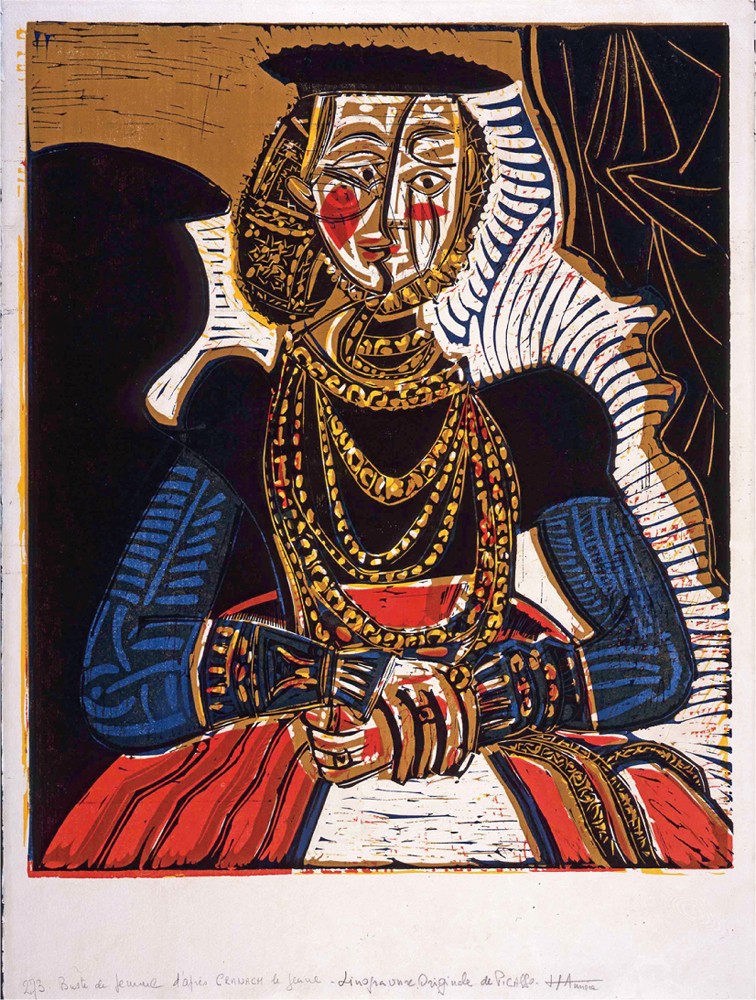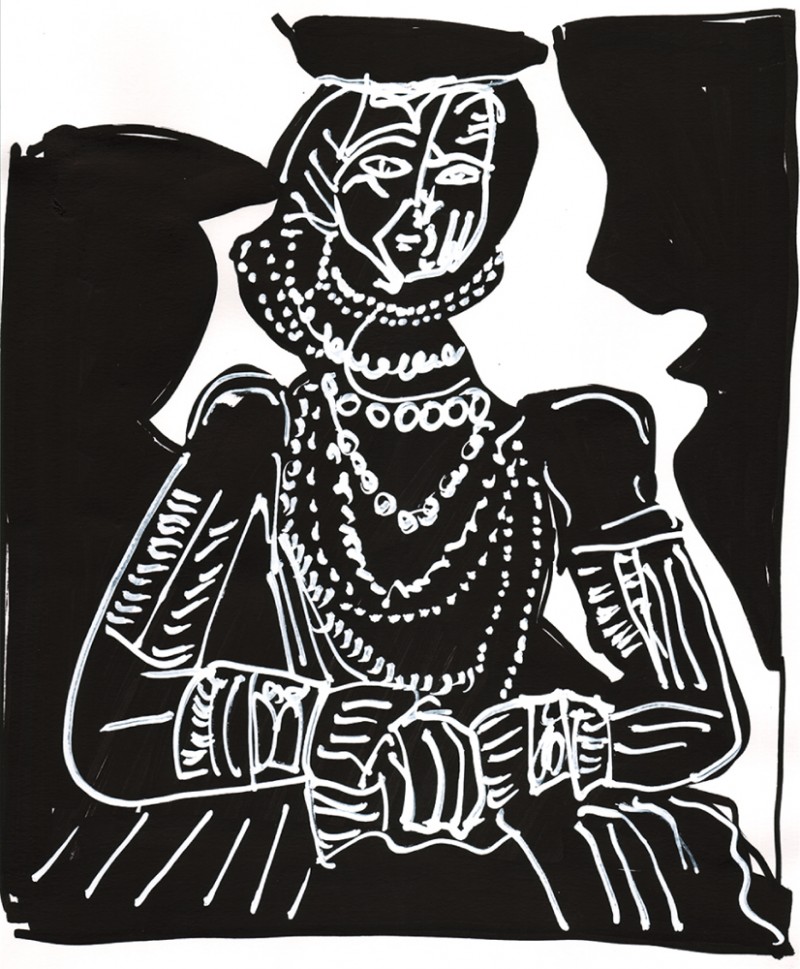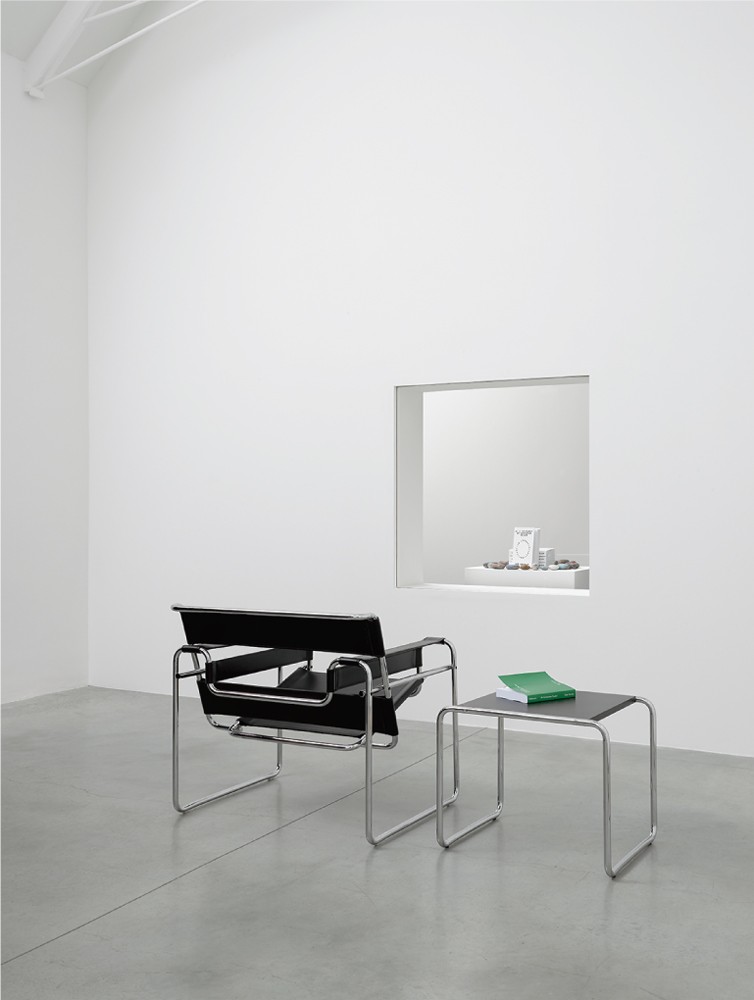Taking a Gander
Two Faces of Picasso
Ryan Gander is a British artist, filmmaker, designer and consultant to landscape firms and property developers. He has written 38 books, the most recent being Picasso and I, an artist book that is a collaboration with the Remai Modern Art Gallery in Saskatoon, where he interpreted, chose and installed a selection from the 406 linocuts by Pablo Picasso in the museum’s collection. The Remai Modern also includes in their collection Gander’s Fieldwork 2015, a conveyor-belt piece on which 33 personal objects can be seen through a window as they pass by the viewer. Ryan Gander was interviewed by Border Crossings in Saskatoon on October 21, 2017.
BORDER CROSSINGS: You treat Picasso as if he were a performance artist who is in the process of performing his own life.

Pablo Picasso, Portrait de Jeune Fille, d’après Cranach le Jeune II, 1958, linocut on paper, 65 x 53.5 cm. Remai Modern Collection. Gift of the Frank and Ellen Remai Foundation, 2012. © Picasso Estate / SODRAC (2017).
RYAN GANDER: It is a perspective, isn’t it? My work is primarily ideas-based and not practice-based. I’m not really an artist; I’m more interested in semiotics and language, and language outside the things that are communicated in the gallery, so both the natural and conventional signs of an artist’s persona are interesting to me. If you think of Panamarenko, the Belgian artist, he is an aviator and an inventor; or Joep van Lieshout, the Dutch artist, can be thought of as a racing car driver; Damien Hirst is a self-publicist, an entrepreneur and an advertising man before he is an artist; and Gilbert and George go to the same tailor and have exactly the same suits, but one has an extra pocket. All these bits of information are important to their personae. So deconstructing the semiotics of Picasso’s persona was obviously the first thing that interested me.
And what interests you is how he used photography to present himself in various guises?
Yes. When we think of Picasso we see a picture of him as a caricature with a revolver and a cowboy hat, or we think of that infamous picture with his hand on the table in an old chateau kitchen and each of his fingers is actually a bread roll, or him holding the umbrella for Françoise Gilot on the beach. Don’t get me wrong; I love art and I recognize his contribution to knowledge and to history, but that’s not all he did. There is even a song about him in the 1970s by Jonathan Richman of The Modern Lovers that goes, “Well some people try to pick up girls and get called assholes, but this never happened to Pablo Picasso.”
You go so far as to imagine yourself as if he were your persona.

Ryan Gander, An attempt at a facsimile of Pablo Picasso’s Portrait de Jeune Fille, d’après Cranach le Jeune II, (1958), 2017, black Posca marker pen and Tipp-Ex on 160 gsm cartridge paper, 29.7 × 42 cm. Image from “Picasso and I,” 2017, by Ryan Gander. Image courtesy of the artist. © Ryan Gander.
It’s not really me comparing myself to him; it was more like a research exercise because I thought I was underqualified to curate the exhibition. I considered it research to learn what it would be like to merge myself into his persona. My first thought was I should get some Picasso books and read up on him, and then I realized that was ridiculous because that is what a curator would do and that wasn’t what I was asked to do as an artist responding to the collection. So instead of going to the library, I thought, I’ll just redraw every print in the collection until I know what I’m going to do. Because there is no repetition in my work, I do something completely different every single day. There are 406 linocuts in the collection and I think there are in the range of 180 unique images. It was like doing intellectual hard time because I had to sit still and my mind couldn’t jump around and be light on its feet and sporadic. It was kind of suffocating.
What did the process of drawing each of the images teach you about Picasso’s way of working?
With his painting and sculpture he makes something and you see this final thing and there is a ta-dum; the angels sing and the lights shine down on the genius. But in the linocuts you see how he works. It’s like a story being told. When you’re given a series of iterations of a unique image, you understand the journey. But I needed to narrow it down, and two things became apparent very quickly: one was to show all the iterations of a unique image so that you could make comparisons; and the other was that I wanted to show things about the life of Picasso, so I chose portraiture. It’s in the portraits that you can see the people he was close to and surrounded by.
This wasn’t your first encounter with Picasso, was it?
One of the objects in Fieldwork, my conveyor-belt piece, is a napkin with Picasso’s signature embroidered on it. It’s not sampled from his signature but from the back of a Citroën family-type minibus. There is a story about a family member selling his name to the carmaker for a lot of money.
Then, for the version here in Saskatoon, you add a stack of your versions of the linocuts punctured by a metal stake.

Ryan Gander, Fieldwork 2015, 2015, multimedia installation, dimensions variable. Remai Modern Collection. Purchased with the support of the Frank and Ellen Remai Foundation, 2017. Installation view, “Ryan Gander: Fieldwork,” Lisson Gallery, London, 2015. Photo: Jack Hems. Images courtesy of the artist and Lisson Gallery, London. © Ryan Gander.
Yes. When I was doing the redrawings I thought, I should give them to the museum. But then I thought, there is something embarrassing about copying Picasso and then being egocentric enough to offer them to a museum, as if they were worth something. So the only way I could give them to the museum was by destroying them. Then I was in a restaurant and someone put a receipt on one of those spikes, and the guy I was with, a curator, said those spikes are good for accounting because they put things in chronological order and they can’t get mixed up. I thought, that is perfect, because the whole redrawing was based on time and chronology, on keeping them together as a collection and marking them as done. If I put them on a spike they become defunct and valueless, and it gets around the egocentric problem of my museum donation. It added humility and my pride was still intact.
You call your versions “attempts at.” Were you interested in any way in virtuosity? How did you determine how far you would go in the accurate rendering of the originals?
The restrictions of my condition dictated that I had only a permanent fat-tipped marker pen and a Wite-Out instrument, so there was not a lot I could actually do. I’m not that skilled, anyway. Maybe someone who is more skilled would have done more in that direction. But I wanted them to be very lo-fi. I realized that what I was doing had some connection to the way teenagers decorate their folders in high school, or their rucksacks. There was something that wasn’t the quality of Picasso, but a different quality that had a kind of everyday aesthetic to it. That’s when I realized we could do a manga book. They’re black ink on newsprint and they have that beautiful newspaper smell. I thought, if we go down that route we can make them cheap. The irony is that the market for Picasso books is huge, there are hundreds of them, but they are lavish monographs and no one can afford them. People on fixed incomes can afford this Picasso book. ❚

Ryan Gander, Fieldwork 2015, 2015; Detail: Being Picasso, 2017, artist’s drawings and metal stake. Remai Modern Collection. Purchased with the support of the Frank and Ellen Remai Foundation, 2017. Image courtesy of the artist. © Ryan Gander.

